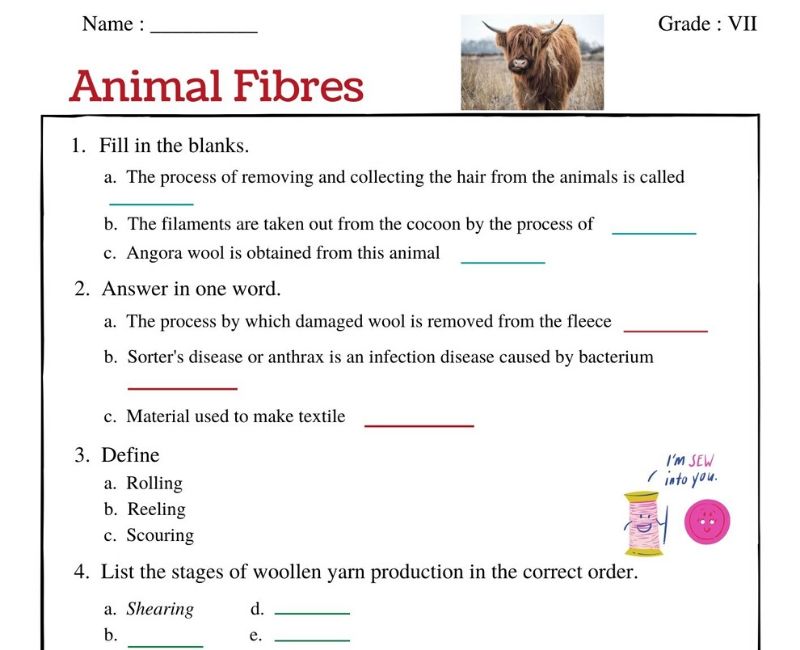Animal Fibres Class 7 Worksheet
Are you excited to embark on a woolly adventure with the Animal Fibres Class 7 Worksheet? The amazing world of animal fibres is not just about sheep and wool sweaters—it's a fascinating exploration into the fluffy and soft materials that animals provide us. Our specialized Class 7 animal fibres worksheet is the beginning of an incredible journey that weaves through the lives of animals like silkworms and goats, who secretly wear the coolest threads!
As you flip through the pages of your Animals fibres class 7 worksheets, you'll uncover how the delicate threads of silk are made by tiny insects with a mighty talent, and how goats in the mountains give us the luxurious cashmere. These worksheets turn complex topics into easy-to-follow quests of learning. You'll discover new terms, dive into thought-provoking questions and even become an expert on how these fibres are transformed into the clothing you love.
But wait, there's more! You won't just be reading about these fibres; you'll engage in activities that'll put your newfound knowledge to the test. This isn't just rote learning; it's a hands-on, minds-on exploration of something we often take for granted.
So, are you ready to unravel the secrets of animal fibres? Power up your curiosity and let the Animal Fibres Class 7 Worksheet guide you through this hairy but heartwarming tale. Embrace the opportunity to become a junior textile scientist and discover a whole new side of the animal kingdom. Let’s get started on this fuzzy quest for knowledge together!
FAQs
Q1: What is animal fibre? Answer: Animal fibre is a type of natural fibre that is derived from the hair or fur of animals. These fibres are typically used in the textile industry to create a variety of products such as clothing, blankets, and carpets. The properties of animal fibres, such as their warmth, durability, and texture, make them suitable for different uses in textile manufacturing.
Q2: Can you give some examples of animal fibres?Answer: Absolutely! Some common examples of animal fibres include:
- Wool: This is perhaps the most common type of animal fibre. It is derived from the fur of sheep and is known for its warmth and durability.
- Cashmere: This is a type of wool that comes from cashmere goats. It is known for its softness and luxurious feel.
- Angora: This fibre comes from the fur of Angora rabbits. It is incredibly soft and fluffy, making it ideal for use in high-end clothing and accessories.
- Silk: This is a unique type of animal fibre that is derived from the cocoons of silkworms. Silk is known for its smooth texture and shiny appearance.
Q3: What is the difference between plant fibre and animal fibres?Answer: Plant fibres and animal fibres are both types of natural fibres used in the textile industry, but they have different properties and come from different sources.
- Source: Plant fibres, as the name suggests, are derived from plants. Examples include cotton from the cotton plant and linen from the flax plant. Animal fibres, on the other hand, come from animals, such as wool from sheep and silk from silkworms.
- Properties: Plant fibres are generally tougher and can withstand more wear and tear, making them suitable for items like bags and rugs. They are also more breathable, making them ideal for summer clothing. Animal fibres, on the other hand, are generally softer, warmer, and more insulating, making them suitable for winter clothing and blankets.
- Processing: The processing of plant and animal fibres also differs. Plant fibres are usually harvested, cleaned, and spun into yarn. Animal fibres, on the other hand, are typically sheared or collected from the animal, cleaned, and then spun into yarn.






